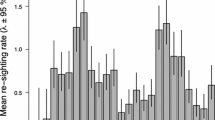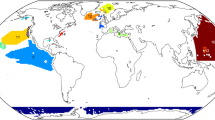Summary
A general method—the Least Square Index Method—for estimating marine mammal populations is developed and applied to the Northwestern Atlantic harp seals. Each age group is allowed to have their own vulnearability, catchability, and natural mortality. The age samples need therefore not be representative of the age structure of the animals on the hunting grounds. The abundance estimates are not dependent on the values of the natural mortalities. The sensitivity to fluctuations in the vulnerability and catchability is tested by simulation. This analysis shows that the estimate of the average pup production,\(\hat B\), is robust, while the estimate of the rate of change in pup production is not robust. Consequently, only\(\hat B\) may be used in the assessment. A new method for estimating the average natural mortality may then be developed by starting a population projection with\(\hat B\). The estimates obtained by the Least Square Index Method are: Average pup production in the 1960's: 400 000; Average natural mortality: 0.105; Pup production around 1980: 390 000.
Similar content being viewed by others
References
Allen RL (1975) A life table for harp seals in the Northwest Atlantic. Rapp P-Verb Reun, Cons Int Explor Mer 169:303–311
Benjaminsen T, Øritsland T (1975) Adjusted estimates of year-class survival and production with estimates of mortality for Northwestern Atlantic harp seals. Int Comm Northwest Atl Fish (working paper 1975) 11:38 pp
Bowen WD (1982) Age structure of Northwest Atlantic harp seal catches, 1952–80. NAFO Sci Coun Stud 3:53–65
Capsick CK, Ronald K (1976) Modelling seal populations for herd management. FAO Sci Cons Mar Mamm, Bergen, Norway. ACMRR/MM/SC/77 19 pp
Derzhavin AN (1922) The stellate sturgeon (Acipenser stellatus Pallas), a biological sketch. Byull Bakinskoi Ikhtiologicheskoi Stantsii. 1:393
Eberhardt LL, Chapman DG, Gilbert JR (1979) A review of marine mammal census methods. Wildlife Monogr 63:46
Hjort J, Jahn G, Ottestad P (1933) The optimum catch. Hvalradets Skr 7:92–127
Lavigne DM (1976) Counting harp scals using ultraviolett photography. Polar Rec 18:269–277
Lett PF, Benjaminsen T (1977) A stochastic model for the management of the Northwestern Atlantic harp seal (Pagophilus groenlandicus) population. J Fish Res Board Can 34:1155–1187
Pope JG (1972) An investigation of the accuracy of virtual population analysis using cohort analysis. Int Comm Northwest Atl Fish Bull 9:65–74
Ricker WE (1975) Computation and interpretation of biological statistics of fish populations. Bull J Fish Res Board Can 191:382
Seber GAF (1973) The estimation of animal abundance and related parameters. Hafner Press, New York, 506 pp
Sergeant DE (1971) Calculation of production of harp seals in the western North Atlantic. Redb. Int Comm Northwest Atl Fish 1971:157–184
Winters GH (1978) Production, mortality and sustainable yield of Northwest Atlantic harp seals (Pagophilus groenlandicus). J Fish Res Board Can 35:1249–1261
Øritsland T (1971) The status of Norwegian studies of harp seals at Newfoundland. Redb, Int Comm Northwest Atl Fish 1971:185–209
Author information
Authors and Affiliations
Rights and permissions
About this article
Cite this article
Ugland, K.I. Abundance estimation of the Northwestern Atlantic harp seal population. Polar Biol 4, 187–198 (1985). https://doi.org/10.1007/BF00999763
Received:
Accepted:
Issue Date:
DOI: https://doi.org/10.1007/BF00999763




